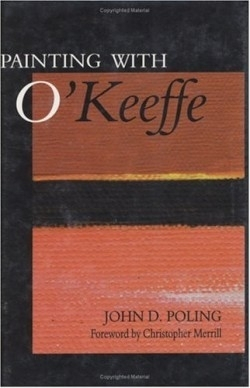Painting with O'Keeffe
This is a strangely sad and compelling memoir, like a story told at a bar frequented by artists. In the summer of 1976 a local boy hitches a ride from a white Mercedes convertible. The austere smiling woman in the passenger seat is legendary artist, then eighty-nine-year-old, Georgia O’Keeffe. Soon he is hired as handyman at Ghost Ranch by her business manager Juan Hamilton, who, while in New York to oversee her art books, instructs Poling to assist O’Keeffe “in whatever she needs.” O’Keeffe comes to like sharing lunch with this twenty-three-year-old minister’s son with his guitar and love of the red mesa megaliths. He moves from window trim repair to answering her mail and reading aloud to her. “Can you paint?” she asks. No, he answers. Thus begins O’Keeffe’s rigorous master class: to turn him into her eyes and hands for new work. For O’Keeffe, as few then knew, is nearly blind. Their first collaboration, described in rich detail, is a success, borrowing from one of her studio works. Hamilton then returns, and almost immediately O’Keeffe goes silent. He begrudgingly approves Poling’s work and allows a few new efforts, but then summarily dismisses Poling. O’Keeffe sits mute to his appeals.
The story might have ended here, with a by-now Yale Divinity School student earnestly musing on his season in the New Mexico sun, had he not recognized, a few years later, his own canvases featured in ARTnews magazine and touring the country under O’Keeffe’s imprimatur. Given the notion of full disclosure, the coda is painfully predictable: O’Keeffe’s round contempt for Poling’s bid for modest attribution of his contribution. (“He was a palette knife, he saw nothing; does a sculptor advertise his foundry?”) Her defense is lofty but disingenuous, for she could no longer publicly deny her blindness. Poling hardly seems a coattail chaser of fame, more like an exile from Eden seeing the serpent take up residence. His epilogue about her legacy of seeing nature as it is does quiet justice to his teacher. And the appendix of his finally telling newspapers his own story show a keyhole glimpse into the last years of O’Keeffe and her own rage against the dying of her beloved New Mexico light.
His first painting “Patio Door” was allegedly destroyed by O’Keeffe. No copy exists. Their subsequent work, inspired by her visit to the Washington Monument, were variously titled “From a Day with Juan.” Permission to reproduce these were denied by the O’Keeffe Foundation. O’Keeffe died in 1986 at the age of ninety-eight.
Reviewed by
Leeta Taylor
Disclosure: This article is not an endorsement, but a review. The publisher of this book provided free copies of the book to have their book reviewed by a professional reviewer. No fee was paid by the publisher for this review. Foreword Reviews only recommends books that we love. Foreword Magazine, Inc. is disclosing this in accordance with the Federal Trade Commission’s 16 CFR, Part 255.

